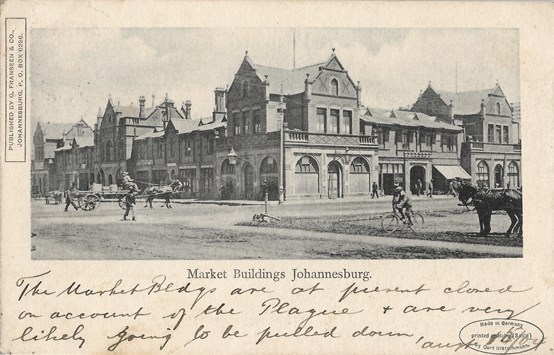TRANSVAAL PICTURE POSTCARD MESSAGES
PLAGUE AT MARKET BUILDING, JOHANNESBURG

The Postcard
Captioned in black ‘Market Buildings Johannesburg.’ the undivided address side is also printed in black. The picture postcard was written and entered the post on the 5th August 1904 and adressed to Mrs Welch, 15 Dodington, Whitchurch, Salop, England. It was published by G. Franssen & Company of Johannesburg, Post Office Box 6296. At bottom right in an oval, it states ‘Made in Germany / printed by Halle (Saale) / by Curt Nietschmann.’
The message
‘The Market Bedgs are at present closed on account of the Plague & are very likely going to be pulled down, Aug 15/04.’
Note
Situated to the west of Market Square, Market Building was erected in 1895, replacing an earlier 1887 two-storey building. Hidden from view in this picture, was a large central hall with shops and offices on all sides. There was also a beer hall, restaurants and a billiard hall. The early morning was probably for bulk-buying, with the public admitted circa 9am.
The South African Republic’s strategy was to sell monopoly concessions to individuals for cash. Therefore, the city lost out on future revenue. When the British took over the city from 1900, the Transvaal, Colonial Secretary* noted that the management of the Market was contra to public interest. However, the Concession was still recognised in 1903. By this time the largest shareholder of the Johannesburg Market Buildings Concessions Company, was possibly one of the large mining companies. Despite the company’s confidence, the change from deliveries to the market by ox-waggon loads was undermined by the railways, where dealers collected goods from the railway instead of the market. Then in 1904 two Europeans who were living in an upper storey of the building, were identified as having contracted bubonic plague. After a dead rat was found and examined, the Plague Committee closed Market Building on the 4th May 1904. There followed a vast bonfire on the night of 18th of May and the building remained closed for a year, but never really recovered to its former importance. The building was eventually demolished in 1915.
* Lord Milner’s administration included about a dozen young men, mostly from Oxford, who became known as the ‘Kindergarten’. It was one of these bright young men, Patrick Duncan, a graduate of Balliol, who Milner recruited from the Inland Revenue Office. He arrived in the Transvaal during March 1901 and was Transvaal Colonial Secretary from 1903-1907. During 1906, he acted as Lieutenant-Governor. By 1909 he was advising Smuts. Later, 1911, he was elected to the Union of South Africa Parliament and held some of the top posts in Government. In 1936 he was appointed Governor-General of the Union of South Africa.
References
Norwich, O.I., (1986), A Johannesburg Album: Historical Postcards, A.D. Donker, Holdings (Pty) Ltd., Craighall, South Africa.
Cripps, Elizabeth Ann, (2012) Provisioning Johannesburg, 1886-1906, submitted, Master of Arts in History at the University of South Africa.
Marlowe, J., (1976) Milner Apostle of Empire, A Life of Alfred George the Right Honourable Viscount Milner of St. James’s and Cape Town, KG, GCB, GCMG (1854-1925), Hamish Hamilton, London
Torrance, D.E., (1996), The Strange Death of the Liberal Empire, Lord Selborne in South Africa, Liverpool University Press.
Thanks for reading this page and keep safe.
- - Transvaal Postcards - -
- - Back to Home page. - -
Copyright © J Woolgar 2020